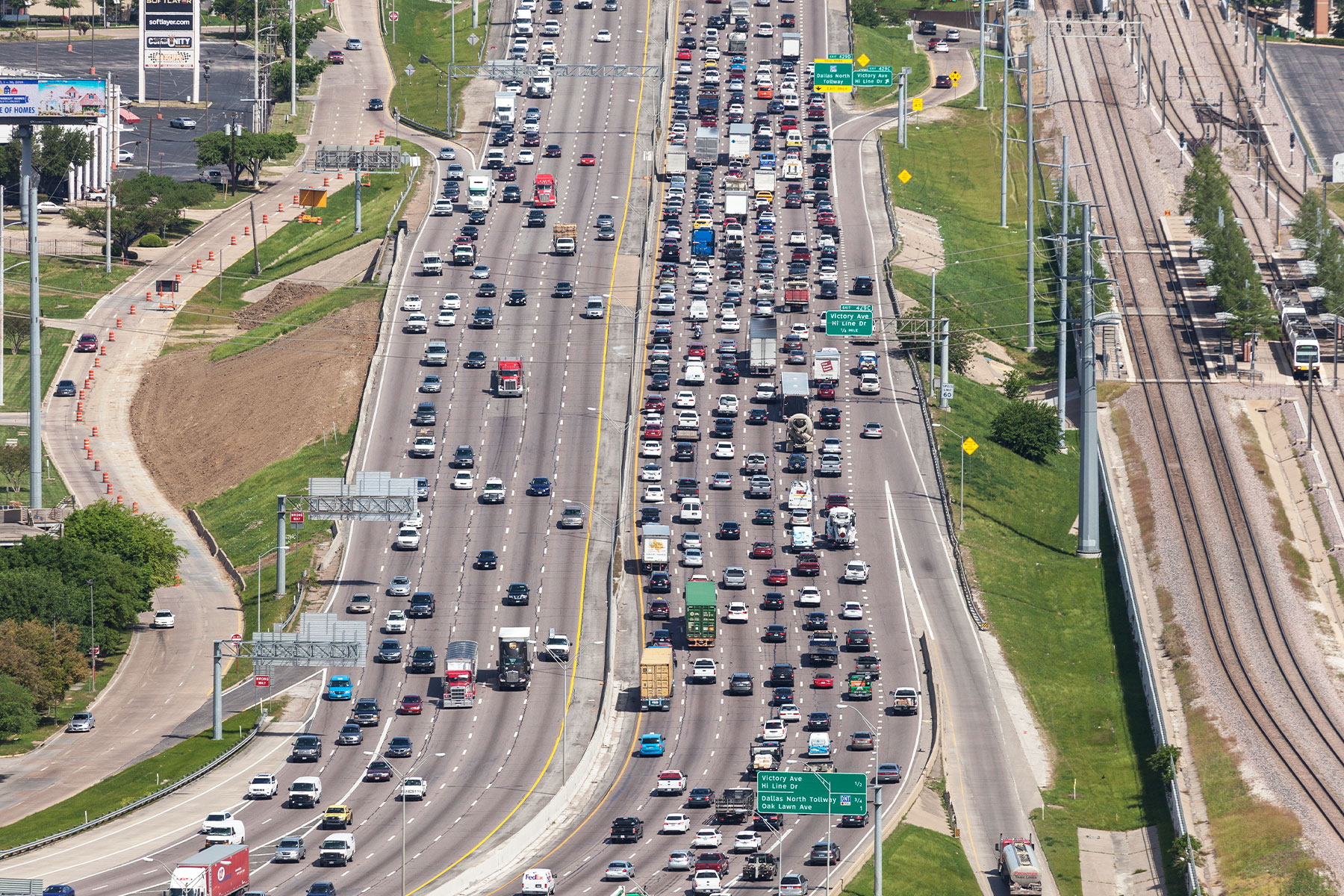We write about the shortcoming of North Texas’ car-centric urban design a lot. Last week, I pointed out how Dallas lags behind other American cities when it comes to bike infrastructure. This morning, Matt reminded us that the city still makes life for pedestrians difficult. We’ve spilled a lot of real and digital ink pushing for things like converting urban highways into boulevards and investing in better and more useful transit.
We devote so much attention to how to make our region’s cities less car-dominated because of all the benefits that come with addressing North Texas’ car-centric design. A less car dependent city would improve neighborhoods’ safety and quality of life, help regenerate inner-city growth and create new jobs, reduce the costs of transportation that contribute to inequality, and lessen the burden on taxpayers for funding a never-ending infrastructure Ponzi Scheme. One benefit we don’t focus on too often is the way in which a shift away from car-centric urban design, particularly in sprawling metros like Dallas, could play an outsized role in the effort to bring global carbon emissions in line with the goals outlined in the Paris Climate Agreement.
The BBC has a new report that looks at the role the United States’ car-centric infrastructure plays in the ongoing effort to reduce global carbon emissions. To drive home how car-centric American culture is, the BBC piece opens by dropping into Arlington, which—as we all know very well—is the largest city in the United States without any public transportation. The BBC isn’t picking on Arlington; it makes the case that the North Texas city is by no means an outlier. No matter where you live in the United States you are likely dependent on cars for all your transportation needs. Since 2017, driving has been the single largest source of greenhouse emissions in the U.S.
In 2019, more than three-quarters of American workers drove alone to work. The vast majority of their cars burn petrol, each emitting an average of 4.6 tonnes of CO2 per year – equivalent to the total yearly emissions of someone living in France. The US also lags behind China and Northern European countries in electric car sales – electric vehicles made up only 2% of all new cars sold in 2020 (75% of cars sold in Norway the same year were electric).
The BBC also reports that the U.S. was responsible for about a quarter of global passenger aviation emissions in 2019. Taken together it becomes clear that any attempt to substantially reduce the United States’ contribution to climate change will need to address the fact that we drive and fly virtually everywhere.
That’s not going to be easy because, as the BBC points out, since the end of World War II we’ve built a country in which it is all but impossible to use a form of transportation that isn’t a car or truck. In other words, it is not drivers who are at fault for all those emissions. Even if you wanted to give up the car and begin using other, less-impactful means of transit, in places like North Texas, the option just isn’t there. The irony, the BBC points out, is that the car has come to symbolize American freedom, and yet it has also made us slaves to a single form of transit.
It’s easy to see why having a car in the US is synonymous with mobility and freedom to travel – without one, you’re beholden to poor transit services that might include one-hour waits for buses that may or may not arrive, minimal or non-existent bike lanes and limited rail service, among other challenges. The car-centric infrastructure and culture of the US is also the crux of its greenhouse gas emissions.
The solution: change the way American cities are built. But as anyone who has closely followed the progress around projects like boulevarding I-345 or improving DART’s service knows all too well, it is not easy to change infrastructure. It takes decades and requires loads of political will. The BBC article covers the many bureaucratic and political roadblocks that its overseas readership may not be familiar with, but which we cover frequently. Historically, the U.S. funding for auto infrastructure has vastly outpaced any other mobility investment. Local council politics can complicate, stall, or ruin all sorts of decisions around transportation and land use planning. There is never enough federal or local funding for public transit.
The article also includes a few interesting outsider observations. One is that public transit projects in the U.S. often run over budget simply because, without much existing transit, there is little institutional knowledge to guide project management. This isn’t the case in European and Asian cities that have been building and relying on transit for decades.
Then there is that other old foe—parking:
It’s been estimated that the U.S. has as many as two billion parking spaces – that’s around eight spots for every car. In many places, local planning laws require developers to build abundant parking into their projects. “You have an enormous feedback loop,” says Adie Tomer, expert in metropolitan infrastructure at the Brookings Institution, a non-profit based in Washington. “There’s ample free parking, which incentivises people to drive, which incentivises people to purchase cars, and then more people build both residential and commercial development to accommodate those cars.”
So, what can the U.S. do if it wants to reduce its transport emissions? Two big picture ideas raised in the report: converting to electric cars and introducing new carbon taxes. Neither comes across as viable. One analysis argues that the U.S. would have to make a 100 percent transition to electric vehicles by 2030 to meet the emissions reduction goals set by the Paris Climate Agreement, which is both unlikely to happen and would create new problems like straining the electric grid and increasing demand for the problematic mining of the minerals used in battery production. Creating new taxes to dissuade people from driving would cause financial strain on many people, particularly low-income individuals who have no option but to drive to their jobs.
The closest thing to a solution this BBC report arrives at is to look at the success that has been made by local, grassroots approaches to fixing urban infrastructure. The report mentions the successes of refocusing public transit investment on making bus systems more efficient and reliable, which DART is currently undertaking. It talks about how cities that have invested in small scale improvements to pedestrian and bicycling infrastructure have reaped outsized benefits:
Similarly, cities have found that if you build safe and reliable infrastructure for walking and biking, the cyclists and pedestrians will come. The majority of trips Americans take are less than three miles (4.8km) – distances that many can make by foot and bike. These modes are truly the greenest travel – daily cyclists on average have 84% less emissions associated with their travel than non-cyclists.
The good news here is that, as congress continues to haggle over an infrastructure bill that is getting more diluted by the day, this new report offers evidence that local efforts to expand mobility freedom may be more effective than any huge government subsidy for electric vehicles. In fact, many of the big picture goals of the bill—like combating climate change—might be better addressed by availing local governments with the funding needed to improve their own urban environments. Because when you improve local infrastructure and make it more friendly for cyclists, pedestrians, and transit riders, formerly car-bound people begin to enjoy their newfound freedom:
These local changes build momentum and support, says [Jonathan] English, [transport director of the chamber of commerce and advocacy group Toronto Region Board of Trade], which can help the changes stay even as politicians come and go. “The more riders you have, the more money you have, the more political support you have,” says English. “Once you build a strong constituency of riders, you have a strong political voice that makes it impossible to then obliterate transit service down the line.”




